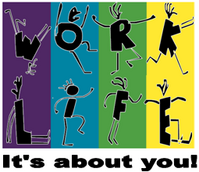June Work/Life Line: Does Your Back Hurt?
06/15/11
Contributed by Alison Bowman
 About the Spine
About the Spine
The spine or backbone is a large column that extends from the base of the skull to the pelvis. The spine is composed of 33 bones and tissues called vertebrae. There are five types of vertebrae: Cervical, Thoracic, Lumbar, Sacrum and Coccyx.
What Causes Back Pain:
Back pain is not a diagnosis in itself; it is a symptom of a larger medical problem. These medical problems can include:
- Mechanical problems: A mechanical problem is “due to the way your spine moves or the way you feel when you move your spine in certain ways.”
- Examples of Mechanical causes of back pain include: spasms, muscle tension, and ruptured/herniated discs.
- Injuries: Injuries such as sprains and fractures can be short term or chronic back problems. Back injuries can be caused by accidents or falls.
- Acquired conditions and diseases: Medical conditions such as scoliosis, spondylolisthesis arthritis(including osteoarthritis, rheumatoid arthritis, and ankylosing spondylitis) and spinal stenosis can cause or contribute to back pain. Other medical causes of back pain include osteoporosis, pregnancy, kidney stones, endometriosis, and fibromyalgia.
- Infections and tumors: Although rare, infections can cause osteomyelitis which can cause back pain. Tumors also rarely can begin in the back or originate in other parts of the body and spread to the back, causing pain.
Risk Factors
- Risk Factors you cannot change: Being middle-aged or older, being male, family history of back pain, having had a previous back injury, being pregnant, having had compression fractures of the spine, previous back surgery or having had spine problems since birth (congenital spine problems).
- Risk factors that you can change: Not getting regular exercise, jobs that put stress on your back, Smoking, being overweight, poor posture, stress, depression, certain medications weaken bones if used long term.
Treatment
Treatments for back pain include medication, bed rest, physical therapy, exercise, chiropractors, acupuncture and cognitive behavioral therapy.
Prevention
- Specific exercises: Talk to your doctor for suggestions.
- Lumbar support belts: for individuals whose job requires frequent heavy lifting
- Proper sitting and standing posture.
- Find the proper mattress for you individual needs.
- Lifting objects properly
This information was provided by web MD. For more information please visit: http://www.webmd.com/back-pain/guide/back-pain-overview-facts
Don’t forget to sign up for the Back Pain Lunch and Learn on Thursday, June 23rd from 12:30- 1:30pm in the Peggy R. Williams Center, HR Conference Room G-52. RSVPs are appreciated. Please call 4-8000 or e-mail benefits@ithaca.edu to RSVP.
Individuals with disabilities requiring accommodations should contact Alison Bowman in Human Resources at abowman@ithaca.edu or x4-8000. We ask that requests for accommodations be made as soon as possible.
Work/Life: We believe in the integration of work and life outside of work.
1 Comments
https://www.ithaca.edu/intercom/article.php/20110615162547794
 About the Spine
About the Spine About the Spine
About the Spine